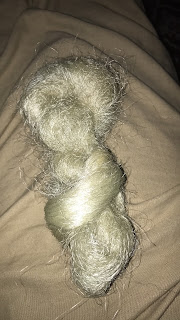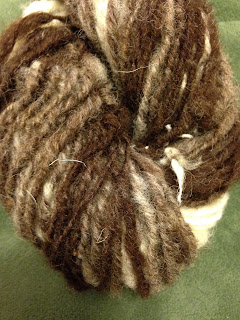Why do people use wool for knitting? Why do people have such a negative idea of wool?
To begin this discussion, what is wool? Wool is the protein fiber that grows on sheep. It is shorn or shed from the animal and is then spun into yarn. That's the short of the whole process.
But why do so many people have a bad impression of wool? Maybe they shrank their favorite sweater, maybe it's itchy, maybe they've heard from so many people that it is itchy and they just believe it.
Not all wool is made the same. As we saw from my previous posts about the fiber samples, wool comes in many different colors, lengths, weights, etc.. The best thing to do is to go to a yarn shop and feel all the wool yarns they have; do the neck test. The neck test is when you take a skein or hank of yarn and put it on your neck. The feeling on your neck will tell you a lot. If you find it itchy, there are many reasons why. Wool yarn is made from, for the sake of understanding, the "hair" of the sheep. Fiber is measured in microns. The micron measurement is based on the average diameter of the fiber. Human hair, by comparison, ranges from .017 to .18 millimeters, according to Wikipedia. Wool fibers range any where from less than 21 microns to over 45 microns. The comparison of the two is that 1 micron is .001 of a millimeter. So, fiber diameter is one variable.
 Now, you might ask, well what makes wool so variable? It's the same reason why human hair is so different. People from different parts of the world, or with different ethnic backgrounds have vastly different hair. If you look at your own body hair, (this is a lot easier on a hairy, Italian guy) depending on where it grows on the body can yield a very different hair. Pardon the slightly disgusting comparison, but, my sample of Black Welsh Mountain wool (left) was very comparable to pubic hair; that would not make a very comfortable garment. Yet, many of the wool samples I've spun have been like cotton candy. Now who wouldn't like a cotton candy sweater, except maybe a diabetic. Today there are so many new indie dyers and spinners making wonderful yarns from their local wool, you really should see and feel what they have to offer.
Now, you might ask, well what makes wool so variable? It's the same reason why human hair is so different. People from different parts of the world, or with different ethnic backgrounds have vastly different hair. If you look at your own body hair, (this is a lot easier on a hairy, Italian guy) depending on where it grows on the body can yield a very different hair. Pardon the slightly disgusting comparison, but, my sample of Black Welsh Mountain wool (left) was very comparable to pubic hair; that would not make a very comfortable garment. Yet, many of the wool samples I've spun have been like cotton candy. Now who wouldn't like a cotton candy sweater, except maybe a diabetic. Today there are so many new indie dyers and spinners making wonderful yarns from their local wool, you really should see and feel what they have to offer.
The next variable is how the wool was spun. The same sample of wool could be spun worsted and make a very fine thread, think of a fine wool suit, or it could be woolen spun and make a very lofty soft yarn. (left, woolen spun Finn, right worsted spun Finn)
If we look to the psychology behind wool we can see many other reasons why people don't like wool. I believe this to go back to our mothers, and or grandmothers. If we look back to the 1930's and 40's during war time, wool was an important fiber for military uniforms, so it was in scarce commodities to the regular person. What did they do? they recycled old wool. Recycled wool was wool that was taken from yarn, fabric, second cuts, etc., and combed out. This broke the fibers and made it very rough to the touch. Many garments were made from this fabric and some generations lost the feeling of pure new wool, which is where that label came. Pure New Wool, is wool that hasn't been used for anything but this garment. Today recycled wool is sometimes used for rugs and carpeting.
Why should you use wool for your next project? This is a big question. I think the first fear in using wool for a project is it's washing. Yes, wool felts. Wool felts from hot water and agitation. So wash in cool water and by hand. Or if you are lucky and have a fancy new washing machine, wash it on super delicate hand wash cycle. I have done this with cashmere sweaters and they did not felt at all. We also have to let go of the idea that if we wear a garment once it has to be washed. If you don't spill on your sweater you don't have to wash it. I generally only wash my sweaters a few times a year. You definitely want to wash them before going into storage to prevent moths. When drying your sweaters, lay them out on a towel, roll them up into it and squeeze. You'll be amazed how much water comes out. Why should I be worried about shrinking when I can use superwash, or shrink free wool? Some superwash wools are terrible. To make wool superwash there are many things that happen to it. Most of these treatments involve chemicals. Wool fibers are coated with a plastic like coating to prevent the scales on the fibers from locking, these scales are the reason why it felts. Other treatments involve pre-shrinking the wool before it is spun. Do yourself a favor and look it up yourself, you will be surprised how much goes into making shrink proof wool.
This brings up another reason why wool is so wonderful, it's wicking properties. Wool can absorb a lot of water. For example, early firefighters would have wool suits that they would soak in water prior to entering a burning building to prevent it from burning. Wool can also be semi water proof. In the past raw wool was spun in the grease to keep it from absorbing water, seeing as how we know that water and grease do not mix.
Wool can be expensive, but if you are spending upwards of 40 hours of work on a sweater, don't you want it to be the best damn thing you can make? Wool has forgiveness that man made fibers do not have. Blocking can make all the difference in the final project of a wool sweater. These results will most likely not happen in acrylic. Also use your head when thinking about your project. Don't use a luxury fiber, like cashmere, for an out door sweater. Use something that has good body and nice insulation.
I don't think anything is better than a wool sweater, especially one that is hand made with love. It is time you take pride in your knitting. Go out in public and knit and see how many people are fascinated by what you are doing. Take pride in the fact that you are making something with your hands. And never say "oh, I'm just knitting"; most people don't have those motor skills. So, be proud of your skills and their outcomes, and buy some wool for that next project. You can also be very supportive of your local economy by doing so. Most yarn shops have a local section that may include local wool. And last, but not least, do a sheep a favor and use it's wool, it'll have another fleece next year.































 Again, note the size next to a pencil.
Again, note the size next to a pencil.














